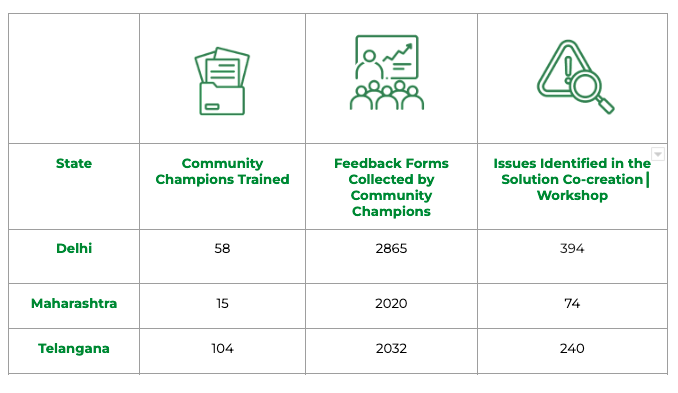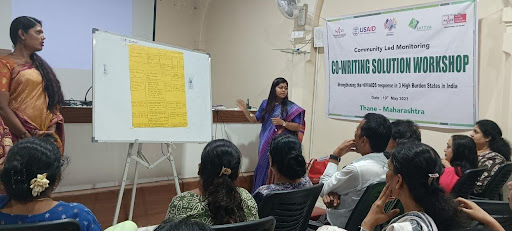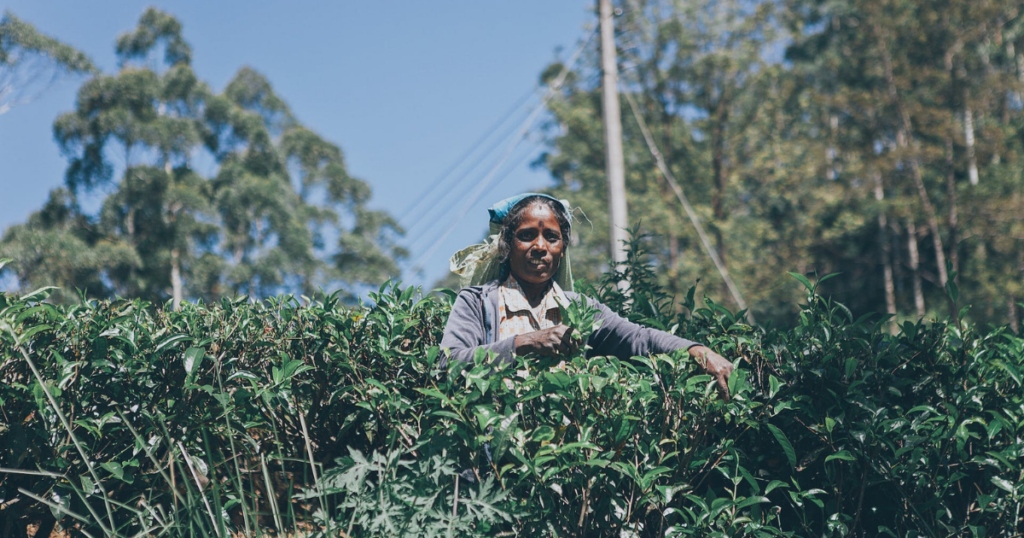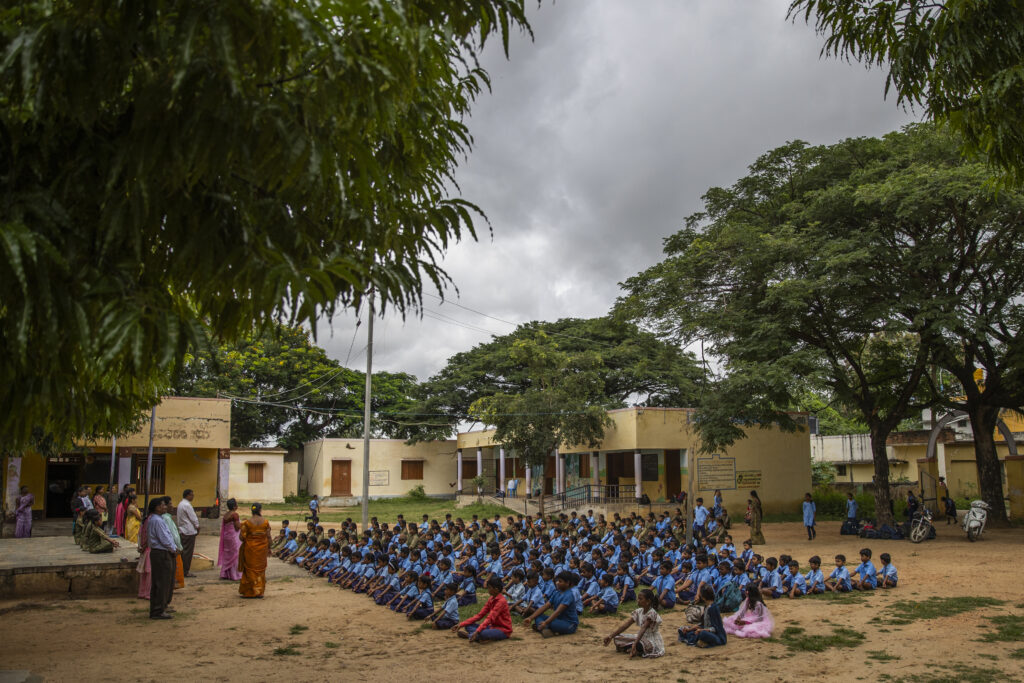HIV/AIDS remains a looming concern across the globe and India is no exception. Although there have been significant advances in the prevention and treatment of HIV/AIDS in India in recent years, the epidemic remains a major public health challenge. To move closer to the end of AIDS as a public health threat, enhanced HIV service delivery, informed decision makers and empowered communities show promise when looking to curb HIV prevalence.
CLIENT BRIEF
Recognising an urgent need to respond to the HIV epidemic, the Community-Led Monitoring (CLM) programme was implemented with the support of The United States Agency for International Development (USAID), the U.S. President’s Emergency Plan for AIDS Relief (PEPFAR) and National AIDS Control Organisation (NACO). This was done as a part of NACO’s focus on Community System Strengthening (CSS), which prioritses creating systems and frameworks that communities can learn to independently operate.
In three years, the programme aims to improve HIV service delivery in 14 high HIV burden districts across three states – Delhi, Maharashtra and Telangana, and in turn improve HIV diagnosis, treatment and prevention, to ultimately lead to the goal of improved HIV outcomes in these areas. HIV awareness, destigmatisation, rights advocacy and community empowerment are woven into the programme implementation as they play an integral role in achieving this goal.
SATTVA’S APPROACH
Sattva is responsible for the end-to-end execution of this engagement. We are adapting tools that have been piloted in consultation with the National Working Group of Community System Strengthening, NACO and all concerned stakeholders including community organisations.
With the programme’s polestar being HIV service delivery enhancement, Sattva is implementing the programme to enable and empower key populations and people living with HIV to assess HIV services and collaborate to improve them, leading to quality services delivery through CLM.
Our team is working towards facilitating co-solutioning between government stakeholders, HIV service providers, and community members, to address the barriers that prevent people living with HIV and those at a high risk of contracting it, from accessing quality HIV services. By doing this, the programme aims to instill accountability in health systems that ensures community appropriate service provisioning through shorter feedback loops, advocacy and strengthened community structures.
Programme Implementation and Management
Sattva is responsible for the mobilisation of teams and activities on the ground and ensuring their alignment with the project’s objectives and timelines.
Programme Monitoring and Evaluation
The CLM project employs a robust monitoring and evaluation framework to track its progress and ensure effective implementation. The project’s activities involve routine feedback collection from service users by community champions and the identification of key issues through co-creation workshops. The feedback collected is analysed to generate valuable insights, identify gaps in service delivery and inform targeted actions for improvement, based on the theory of change, which highlights outcomes and outputs of CLM, with regards to its overall objectives. Regular monitoring and evaluation enable the project team to assess the impact of their interventions, make evidence-based decisions and facilitate continuous learning and adaptation for enhanced HIV service delivery.
RESPONDENT PROFILE
- Geography covered: Seven districts in Delhi, five districts in Telangana and two in Maharashtra. In total – fourteen districts across Delhi, Maharashtra and Telangana
- Scale: Feedback on HIV services has been collected from 6887 service users in the first round of CLM across the three states. As the programme gains popularity, this number is expected to grow in subsequent rounds of feedback collection
- Relevant demographic markers: The programme focuses on people living with HIV (PLHIV) and populations that are at a high risk of contracting HIV. This includes female sex workers (FSW), transgenders (TG), men who have sex with men (MSM) and injecting drug users (IDU). In this manner, the programme takes diverse demographic factors into account, such as age, gender, employment and sexual orientation.
- Partners: The National AIDS Control Organisation (NACO), the State AIDS Control Societies (SACS) of the three States and the respective District AIDS Prevention & Control Units (DAPCU) play a cohesive role in achieving CLM’s common goal of enhanced HIV service delivery
By mobilising Sattva’s field teams and community representatives to connect with their concerned SACS and DAPCU, government officials, healthcare providers, community representatives and members, field teams build strong relationships with the programme’s stakeholders, which enables better engagement and efficient data collection from all relevant stakeholders. This data is analysed and its insights are used to generate problem areas that are to be focused on to improve service delivery.
KEY TAKEAWAYS
- The CLM programme works closely with service providers to help them better understand the circumstances, challenges and issues faced by key populations. This is done to sensitise service providers to the needs of communities, so that they can provide better services that are backed by a clear understanding of the people they serve
- The programme closely assists with the nomination and selection of Community Champions. Once selected, Champions are trained on the processes and stages of CLM, and their interviewing skills are developed so that they can tactfully interact with key populations to collect accurate client feedback from service facilities
- To actively work towards improving service delivery, client feedback is central. It is analysed to identify problem areas that need to be addressed in order to improve HIV service delivery and, therefore, its utilisation by key populations
- To break down silos and promote synergy, it is essential that all stakeholders are involved in the solution co-creation process. This process fosters collaboration and helps identify the root causes of service delivery issues, while generating consensus on actionable solutions
- There was significant involvement of key service providers in the process of identifying issues, creating actionable insights and timelines. This approach made use of local human resources that aided in collective problem solving on a real time basis at the field level, and provided a platform for collaboration through which experiences were shared and skills were strengthened
- Action points to solve issues not only ensure the improvement of service delivery, but their consistent tracking by Community Champions ensures that they are implemented quickly and instills accountability in the facilities
- Throughout the programme’s stages, it was evident that Community Champions served as bridges that could effectively communicate between communities and all CLM stakeholders
- This programme provides a platform for strengthening relationships in the HIV/AIDS response system based on a shared understanding and a common response to enhancing service enablers and addressing barriers to service delivery
- The programme creates resilient, equitable and sustainable HIV programmes by recognising and recreating successful practices across the continuum of care so that field level issues are resolved within a specific timeline without the need for intervention from the state and national level
- Engaging the community in every step of project planning, assessment and implementation gives them an opportunity to be a part of effective programme implementation for themselves. This contributes to the objectives of CSS and also helps empower communities to voice their opinions and hold the healthcare system and its providers accountable.
PROJECT DELIVERABLES
CLM’s primary focus is to get inputs from recipients of HIV services in a routine and systematic manner and for this information to be translated into targeted action that can help address gaps in service delivery. It is also important for the programme to provide support to community engagement and mobilisation while also providing technical assistance for CSS.
- Improvement of HIV outcomes that are tracked by the UNAIDS’ 95-95-95 strategy
- Creation of a second line of leadership for communities, which involved training community representatives to serve as a liaison between the decision makers, service providers and the programme’s key populations
- Creation of training material for community representatives, to prepare them for their roles as community leaders who are also known as Community Champions
- Creation of feedback collection tools and processes
- Data collection from HIV service users at targeted service facilities
- Data analysis to generate insights and identify issues that must be addressed to attain enhanced HIV service delivery
- Developing a shared understanding of enablers and barriers to treatment retention, between all relevant stakeholders
- Facilitation of co-solutioning for identified issues, between government stakeholders, service providers, implementing and partner organisations, community based organisations and community representatives
- Influencing policy changes that can lead to the achievement of universal health coverage
- Ultimately, relationship building with key stakeholders is integral to the programme, which involves taking part in or facilitating other activities related to HIV in each selected district.
IMPACT
In the first round of CLM that was undertaken between January and June 2023, 179 facilities were evaluated in 14 districts of Delhi, Maharashtra and Telangana. At the facilities, 6887 service delivery recipients were interviewed for their feedback by 180 Community Champions, who were all trained by the CLM team in their respective districts.

By evaluating service facilities for the quality of services provided, CLM instills accountability in the HIV health system. This propels facilities to perform better and meet the needs of key populations more efficiently. As more people are interviewed by Community Champions, they are empowered to demand quality services. They do this by assessing and monitoring services to determine their quality. Together, these efforts improve the quality of HIV services and make them more accessible to key populations, thus improving their utilisation.
Replicable best practices that have effectively improved service delivery results are identified in every district to magnify the impact of the programme.
VOICES FROM THE GROUND
- “When I meet someone from my community who is HIV positive, if they haven’t been tested, I take them to get tested and if they are on medication for HIV, I encourage them to diligently continue their course of medication. When they listen to me, I feel proud.” – Community Champion, Delhi
- “I have learned about my right to access quality healthcare services, including ART, counseling and support. I have also become aware of my rights to privacy, confidentiality and non-discrimination in healthcare settings. This knowledge has empowered me to advocate for myself and others living with HIV. I have been able to speak out against discrimination and ensure that people living with HIV have access to the services they need.” – Community Champion, Pune, Maharashtra
- “My goal is to create awareness among members of my community. I’m able to do this by helping and serving them through the CLM programme – this makes me happy.” – Community Champion, Nalgonda, Telangana
- “As a Community Champion, I have gained a deeper understanding of the gaps in HIV service delivery and how they impact key populations. This understanding has helped me identify ways in which I can contribute to meeting the needs of my community.” – Community Champion, Rangareddy, Telangana




